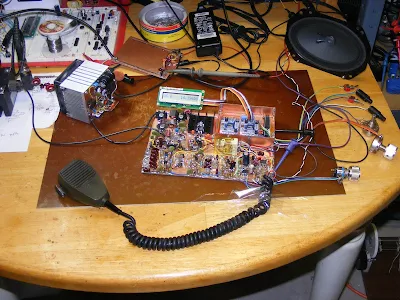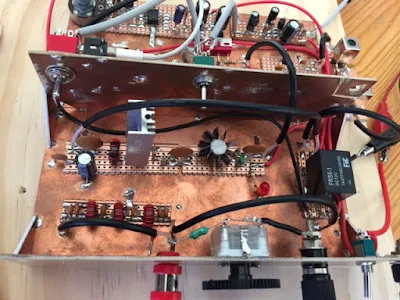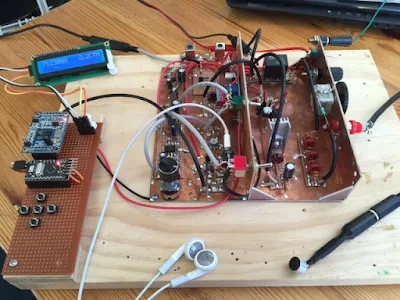And here I thought I was the only one. Apparently not. Bob LeDoux has also built a phasing receiver using a piece of wood as a base. I note also that phasing guru Rick Campbell KK7B built his Classic 40 DC receiver into a solid oak wrap-around case. Bob's receiver is very interesting. That Tayloe Detector is very nice. Phasing is fun! As I type I am listening to Lou, EA3JE on 40 SSB with my phasing receiver.
Bill,
I thought I'd share my breadboard system for receiver experiments. In this example I have a phasing, single sideband Tayloe receiver. The entire receiver, less VFO, pulls 54 milliamps at 5 volts.
The chassis is a prime piece of Oregon pine. Be forwarned; my Tayloe receiver doesn't employ a single discrete transistor.
The DDS VFO at the top is the K5BCQ Si570 based RF generator kit. It reads 56.231 Mhz because the VFO operates at four times the receive frequency on a Tayloe detector.
The receiver consists of five boards. From left to right they are, RF front end filter; Tayloe detector and post detector amps; sideband eliminating phasing filter; eight pole low pass filter; high pass filter and audio amps.
Flexibility is key. Each stage, or set of stages is laid out on one circuit board which is tacked to the breadboard. Controls and jacks are mounted in scrap circuit board and screwed to the side of the breadboard.
Two parallel lengths of thin circuit board are used for the power and ground strips. Electrolytic caps are placed at each board power point. A bit of copper desoldering braid makes the connection between board ground plane and ground strip.
The circuit board is often double sided with the back side used as a ground plane. Holes are only drilled when a ground connection is needed.
Connections between boards are made using .025 diameter header pins soldered to pads. Wire wrap wire is used for connections between the header pins. These pins also make good test points. With SMT construction my intra-board signal lines rarely exceed half an inch. This eliminates coax cable for many connections.
I like to use eight pin op amps for my designs. These provide two stages and four poles in each package. I have a standard board layout. Using this single board, component selection allows low pass, high pass, band pass, gain, or no gain configurations. Multiple linked boards can be etched at one time and cut apart to meet individual circuit requirements.
Let me give credit to Dan Tayloe who developed the original receiver design in the NORCAL NC2030 CW transceiver. I also thank Pete Juliano, N6QW and Nick Kennedy, WA5BDU, for help with current design issues.
Bob--N7SUR--
QRP AM transmitter from AliExpress
-
A low power AM transmitter kit from AliExpress caught my interest. It was
AU$30 and is crystal locked to 21MHz.The board is good quality and went
together ...
1 hour ago















































